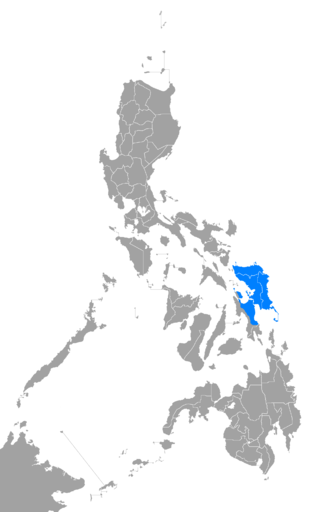Waray language
This article includes a list of references, related reading, or external links, but its sources remain unclear because it lacks inline citations. (May 2015) |
| Waray | |
|---|---|
| Waray-Waray, Samar-Leyte | |
| Winaray, Samarenyo, Lineyte-Samarnon, Binisaya nga Winaray | |
| Native to | Philippines |
| Region | Eastern Visayas (entire Samar and northeastern portions of Leyte province), eastern parts of Biliran and some parts of Masbate and Sorsogon |
| Ethnicity | Waray people |
Native speakers | 2.6 million (2000)[1] 5th most spoken native language in the Philippines[2] |
| Dialects | Standard Waray, Northern Samar |
| Latin; Historically Badlit | |
| Official status | |
Official language in | Regional language in the Philippines |
| Regulated by | Komisyon sa Wikang Filipino Historically regulated by the Sanghiran san Binisaya ha Samar ug Leyte |
| Language codes | |
| ISO 639-2 | war |
| ISO 639-3 | war |
| Glottolog | wara1300 |
 Areas where Waray-Waray is spoken | |
Waray (also Waray-Waray, Samar-Leyte, Winaray, Binisaya nga Winaray, Samarenyo and Lineyte-Samarnon)[3][full citation needed] is the fifth-most-spoken native language of the Philippines, specific to the provinces of Samar, Northern Samar, Eastern Samar, Biliran, and in the north-east of Leyte Island (surrounding Tacloban). The name comes from the word often heard by non-speakers, "waray" (meaning "none" or "nothing"), in the same way that Cebuanos are known in Leyte as "mga Kana" (after the oft-heard word "kana", meaning "that", among people speaking the Cebuano language).[not verified in body]
Dialects
Linguist Jason Lobel (2009) considers there are 25 dialects and subdialects of Waray-Waray.[4]
- Tacloban: "standard" dialect
- Abuyog, Leyte: heavy Cebuano influence
- Culaba, Biliran: heavy Cebuano influence
- Allen, Northern Samar: mostly Southern Sorsoganon mixed with Northern Samarenyo. Dialects in neighboring towns have also borrowed extensively from Southern Sorsoganon.
Waray-Waray is characterized by a unique sound change in which Proto-Bisayan *s becomes /h/ in a small number of common grammatical morphemes. This sound change occurs in all areas of Samar south of the municipalities of Santa Margarita, Matuginao, Las Navas, and Gamay (roughly corresponding to the provinces of Samar and Eastern Samar, but not Northern Samar), as well as in all of the Waray-speaking areas of Leyte, except the towns of Javier and Abuyog. However, this sound change is an areal feature rather than a strictly genetic one (Lobel 2009).[4]
Most Waray dialects in northeastern and eastern Samar have the close central unrounded vowel /ɨ/ as a reflex of Proto-Austronesian *e.[4]
Usage
Waray is one of the 19 officially recognized regional languages in the Philippines and used in local government.[citation needed]
However, print media in this language are rare because most regional newspapers are published in English. The language is also used in the Eucharistic celebrations or Holy Masses in the Roman Catholic Church in the region. Bibles published in Waray are also available.[citation needed]
Loanwords
The language of Waray has borrowed vocabulary extensively from other languages.[which?] These words are being adopted to fill lexical gaps of the recipient language. Spanish colonialization introduced new systems to the Philippine society.[citation needed]
See also
- Waray people
- Waray literature
- Waray Wikipedia
- Visayan languages
- Languages of the Philippines
- Samar
- Leyte
References
- ^ Waray at Ethnologue (18th ed., 2015) (subscription required)
- ^ Philippine Census, 2000. Table 11. Household Population by Ethnicity, Sex and Region: 2000
- ^ Waray-Waray Ethnologue. SIL International.
- ^ a b c Lobel, Jason. 2009. Concise Encyclopedia of Languages of the World, 914-917. Oxford: Elsevier.
Further reading
- Dictionary English Waray-Waray/Tagalog (2005) by Tomas A. Abuyen, National Book Store, 494 pp., ISBN 971-08-6529-3.
External links
- Radyo Waraynon – Waraynon Internet Radio Station
- Waray Museum Blog featuring Waray literature
- Waray lessons
- Bansa.org Waray Dictionary
- Waray dictionary, literary database & teaching resource
- Waray-Waray Dictionary by Andras Rajki – with Bicol, Cebuano, Hiligaynon &c. cognates and some Proto-Malayo-Polynesian etymologies
